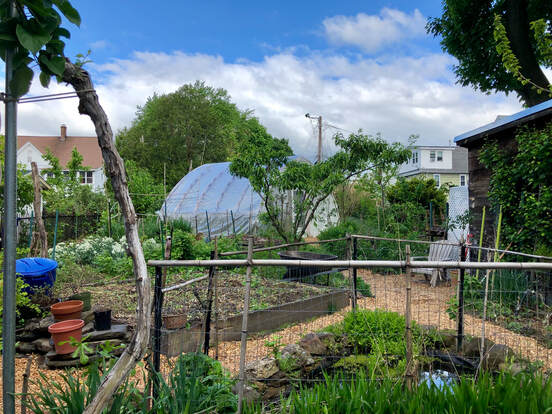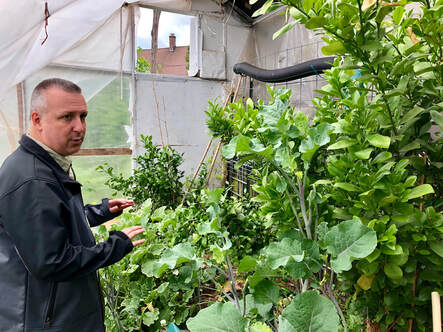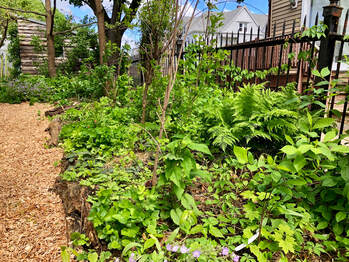Perennial Solutions

Does 1.5 degrees Celsius (2.7 degrees Fahrenheit) weigh on you, as it weighs on me? A temperature increase above this threshold (that is, 1.5 degrees Celsius above pre-industrial levels) may sound minor, but it calls into question our earth’s livability. According to the 2018 Intergovernmental Panel on Climate Change (IPCC) report (https://www.ipcc.ch/sr15/), we are set to meet, and exceed this boundary by 2030, around one decade from now. The report is a strong reminder that we are way off track. That expensive, massive changes are needed to remedy our destructive path. The 1.5 degrees Celsius threshold weighs on me when I fill up at the gas station, when a waitress brings our toddler a disposable plastic cup, lid, and straw because I forget to say “our child doesn’t need a toddler cup,” when my carbon footprint reduction just doesn’t seem quite enough despite my efforts, and when I have to fight the onslaught of mass production and single-use disposable items just to do the right thing. It should be difficult and expensive to buy pesticide-laden fruits and vegetables, not organic. It should be prohibitive to build a house with environmentally destructive materials instead of building with materials like straw bales and earthen plaster. It should be socially frowned upon to grow vast green lawns in the desert instead of diversified, regenerative and functional landscapes. But change isn’t easy and fighting to improve our environment means fighting the system.
Given the enormity of the issues, I am hopeful to discover people, like Eric Toensmeier, who are scaling up permaculture given what we know from the IPCC report. In addition to publishing award-winning books such as Paradise Lot, Perennial Vegetables, and Edible Forest Gardens, Eric lectures at Yale University in their M.S. in Forestry Program, and he is a senior fellow with Project Drawdown. According to Eric, “what I’m doing right now with Drawdown is permaculture design for the planet…at Drawdown we sat down and looked at all the world’s land and we said ‘what are the soils, what are the slopes, what’s the climate, what’s currently the land use there and what are the highest and best uses we can see for that land.’ And that was the basis for the adoption of all the solutions we said.”
 Eric is more excited about permaculture at the global level than the form it has taken in the US. This is primarily due to the economic and social systems within which permaculture functions here. In his words, “permaculture looks really different in Mexico than it looks in the US. And permaculture looks really different in Cuba than it does here. I’m more interested in what it looks like in those places than what it looks like here – where there is actual need, where survival is on the line to a certain degree or where the standard of living is really different, where food security is really different – permaculture is taken up rapidly. But here it actually costs you money. I would be better off just buying from the store. I don’t think I’m saving money [with my home garden] with all the time and money that I’ve put in it. When your economy is so ridiculously steroided up with petroleum and wealth extraction from all over the world, living simply is a privilege and not a need and that just distorts things here. That’s not permaculture’s fault, but it makes it strange compared to, again, what it is like in Cuba or Guatemala where food security is a very real day-to-day thing for those people.”
Eric is more excited about permaculture at the global level than the form it has taken in the US. This is primarily due to the economic and social systems within which permaculture functions here. In his words, “permaculture looks really different in Mexico than it looks in the US. And permaculture looks really different in Cuba than it does here. I’m more interested in what it looks like in those places than what it looks like here – where there is actual need, where survival is on the line to a certain degree or where the standard of living is really different, where food security is really different – permaculture is taken up rapidly. But here it actually costs you money. I would be better off just buying from the store. I don’t think I’m saving money [with my home garden] with all the time and money that I’ve put in it. When your economy is so ridiculously steroided up with petroleum and wealth extraction from all over the world, living simply is a privilege and not a need and that just distorts things here. That’s not permaculture’s fault, but it makes it strange compared to, again, what it is like in Cuba or Guatemala where food security is a very real day-to-day thing for those people.”
Eric makes a good point. Perennial, regenerative residential landscaping only goes so far when our entire consumptive lifestyles are considered. And yet, according to the Union of Concerned Scientists, we rank 2nd among the world’s countries in our contribution to global greenhouse gas emissions (https://www.ucsusa.org/global-warming/science-and-impacts/science/each-countrys-share-of-co2.html). Permaculture and the integrated, systems thinking it fosters (going beyond the landscaping level and applying to all aspects of our lives) is equally critical here as it is elsewhere.
Despite the many flaws in our nation’s economic and social systems, Eric is also enacting positive impacts here on multiple scales. His misgivings about our operating system shouldn’t be mistaken for overall misgivings with permaculture. Since first learning about permaculture while working at a nature center in Philadelphia in 1989, he knew from the onset that it is what he wanted to do with his life. When reflecting on permaculture, he said “it’s doing a lot of the right things. It’s really good at being a grassroots way of spreading information and it’s doing really well at the garden scale. Here in the US, I think it is grappling with the farm scale which is a great next step for us to figure out here,” and it is a step he is working on.
Eric lives on a tenth of an acre, including his house and driveway. When he arrived at his Holyoke, MA, property in 2004 with Jonathan Bates, his 45x90 square foot barren backyard consisted of compacted fill with chunks of urbanite. Now he is growing over 200 perennial species on his lot and has increased his backyard soil organic matter from only two percent to nine percent. On such a small plot, he grows and harvests fruit from the first week of June through New Year’s Eve and he can harvest greens every single day of the year. His property serves as a test site for his research and educational outreach. At a larger scale, Eric is part of the team working on a State Healthy Soils Initiative, inventorying all soils in Massachusetts and making best management practices recommendations. “I’m advising foundations and finance people and producer associations and supply chain people, trying to bring together all the missing pieces in kind-of a permaculture way that are needed to scale it up. Consumers really need to be educated, but if you educate consumers and they can’t buy the product it doesn’t matter. I have people who are getting interested in financing in a big way but we need producer associations.” He is also advising state and federal governments about policy, upscaling his influence to secure funding for and growth of agroforestry and perennial crop production.
Eric has recently published “Carbon Farming: A Global Toolkit for Stabilizing the Climate with Tree Crops and Regenerative Agriculture Practices.” He also published “Guidelines for Perennial Polyculture Design,” which is available for free from the Permaculture Research Institute at https://permaculturenews.org/2016/01/15/guidelines-for-perennial-polyculture-design/. When teaching about polyculture and food forests, the main thing he hopes for is that participants will be able to go home empowered to implement what they have learned. This connects with what first excited Eric about permaculture: “I liked the notion of participating in ecosystems instead of this environmentalist notion I had grown up with where the best you can do is not touch and to shrink our footprint. I like the idea of being fully involved.”
When reflecting further on the mainstream US permaculture movement, Eric said “I feel like it has its own trajectory, it’s doing great, it’s growing well, it’s reaching certain kinds of people at a certain scale very well. But if I died tomorrow, permaculture would be fine. Whereas in the carbon farming world there are things I can do there that not enough people are doing. That is a place where I can have really big impact, that needs me right now.” And his work on larger scales will be included in the next IPCC report.
Ten years. Thanks to people like Eric, we know where we need to go and are more empowered to get there.
To discover more about Eric and Paradise Lot, visit: http://www.perennialsolutions.org/


Recent Posts

